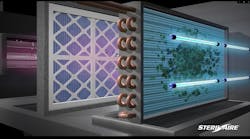By JOE KALMAN, UV Resources
Despite billions of federal dollars made available in response to the pandemic, most K-12 school administrators in the U.S. still have not improved school building ventilation, according to a recent CDC report, "Ventilation Improvements Among K–12 Public School Districts."
Released in April, the report reviewed the last five months of 2022 and found that fewer than half of the 8,410 school districts surveyed had implemented ventilation upgrades recommended by the U.S. Centers for Disease Control and Prevention (CDC) and the U.S. Environmental Protection Agency (EPA) to mitigate COVID-19 transmission.2,3,4
Researchers examined four specific recommended ventilation strategies:
- Maintaining continuous movement of air supply or airflow;
- Replacing or upgrading HVAC systems;
- Installing in-room air cleaners with HEPA filters;
- Installing germicidal UV-C devices.
The federal government allocated $190 billion to help schools recover from the COVID-19 pandemic — more than four times what the U.S. Education Department spends on K-12 schools in a typical year.
That pandemic recovery legislation was designed to help address academic learning loss, prepare schools for reopening, and enhance IAQ by ventilation testing, repairing and upgrading projects. However, based on the new figures from the CDC, more school districts still need to focus on the quality of air their students and teachers breathe.5
Just a matter of time
Many schools have been slow to spend the windfall of federal aid because of the time-consuming process of hiring contractors and meeting state and/or federal requirements. Recognizing this, the U.S. Department of Education has offered to consider spending extensions beyond the late 2024 deadline for obligating the federal relief dollars.
According to the CDC report, just 34% of districts said they had used the funding to upgrade their HVAC systems, while about 28% installed in-room air cleaners, and 8% said they invested in germicidal UV-C.
The most frequently reported ventilation strategy, maintaining continuous airflow in school buildings, was also the least expensive to implement and was reported by approximately one-half (50.7%) of school districts. Advanced strategies such as installing and using in-room air cleaners and germicidal UV-C technology were reported less frequently.
The fact that more schools did not implement the four ventilation strategies studied suggests that —despite billions in federal dollars— the complex issue of air quality requires more evidence-based guidance.
Decision-makers need guidance
Germicidal UV-C, for example, enjoys decades of scientific performance efficacy and is endorsed by the CDC's Ventilation in Buildings guidance and the U.S. Department of Education's Ventilation in Schools and Childcare Programs.6 Further, research shows that operating an upper-room UV-C system in an occupied classroom can disinfect up to 96% of airborne viruses, which is as effective as increasing the ventilation rate more than five times.7
Despite this evidence and scientific data, UV-C technology was the least common engineering strategy in the CDC survey. Still, it was reported slightly more often among school districts in the South and in rural areas.
The most likely explanation?
School administrators are not facility engineers. Even if school officials recognize the importance of air quality and ventilation, they must first hire an HVAC expert to audit their system and recommend specific improvements. Then, they must find a means to independently evaluate the suggested upgrades, convince their administrative board, and apply for state funding.
IAQ tied to academic performance
To help put school air quality in perspective, nearly 90% of classrooms have ventilation rates below recommended minimum standards.8
Researchers with the LANCET COVID-19 Commission found that adequate ventilation and air quality improve students' health, concentration, attendance, and even academic performance:
"In addition to decreased airborne infectious disease transmission, research shows that ventilation and air cleaning improvements are likely to lead to improved academic performance (in particular reading and math performance), fewer missed school days for students, higher scores on cognitive function tests, and many benefits for teachers including decreased respiratory symptoms, increased teacher retention, and improved morale."9
This fall, as K-12 students, teachers and administrators return to class, many resources are still available for completing these vital upgrades to school ventilation systems. So, I urge all of you reading this — engineers, facility managers, and parents — to attend local school board meetings and to urge administrators to take advantage of this unprecedented opportunity. They truly can improve the national climate for learning for generations to come.
About the author
Joe Kalman is director of sales for UV Resources and Steril-Aire and has worked in executive sales leadership and corporate strategy for more than 35 years. He works with leading facilities management companies and HVAC engineers and has written about air quality, how to leverage ROI from germicidal UV-C, and HVAC sustainability issues. He may be contacted at [email protected].
References
1 Mark-Carew M, Kang G, Pampati S, Mead KR, Martin SB Jr., Barrios LC. Ventilation Improvements Among K–12 Public School Districts — United States, August–December 2022. MMWR Morb Mortal Wkly Rep 2023;72:372–376. DOI: http://dx.doi.org/10.15585/mmwr.mm7214a4;
2 CDC. COVID-19: Ventilation in buildings. Atlanta, GA: US Department of Health and Human Services, CDC; 2021. Retrieved from https://www.cdc.gov/coronavirus/2019-ncov/community/ventilation.html
3 Environmental Protection Agency. Indoor air quality tools for schools action kit. Washington, DC: US Environmental Protection Agency; 2022. Retrieved from https://www.epa.gov/iaq-schools/indoor-air-quality-tools-schools-action-kit
4 CDC. COVID-19: Ventilation in schools and childcare programs. Atlanta, GA: US Department of Health and Human Services, CDC; 2022. Retrieved from https://www.cdc.gov/coronavirus/2019-ncov/community/schools-childcare/ventilation.html
5 IBID., 1.
6 CDC Ventilation in Schools and Childcare Programs. Retrieved from https://www.cdc.gov/coronavirus/2019-ncov/community/schools-childcare/ventilation.html
7 Park, S., Mistrick, R., & Rim, D. (2022). Performance of upper-room ultraviolet germicidal irradiation (UVGI) system in learning environments: Effects of ventilation rate, UV fluence rate, and UV radiating volume. Sustainable Cities and Society, 85, 104048. Retrieved from https://doi.org/10.1016/j.scs.2022.104048
8 Allen, Joseph et al. Lancet COVID-19 Commission Task Force on Safe Work, Safe School and Safe Travel: Designing Infectious Disease Resilience into School Buildings Through Improvements to Ventilation and Air Filtration. April 26, 2021. Retrieved from https://static1.squarespace.com/static/5ef3652ab722df11fcb2ba5d/t/60a3d1251fcec67243e91119/1621348646314/ Safe+Work+TF+Desigining+infectious+disease+resilience+April+2021.pdf
9 IBID. 8.##########










